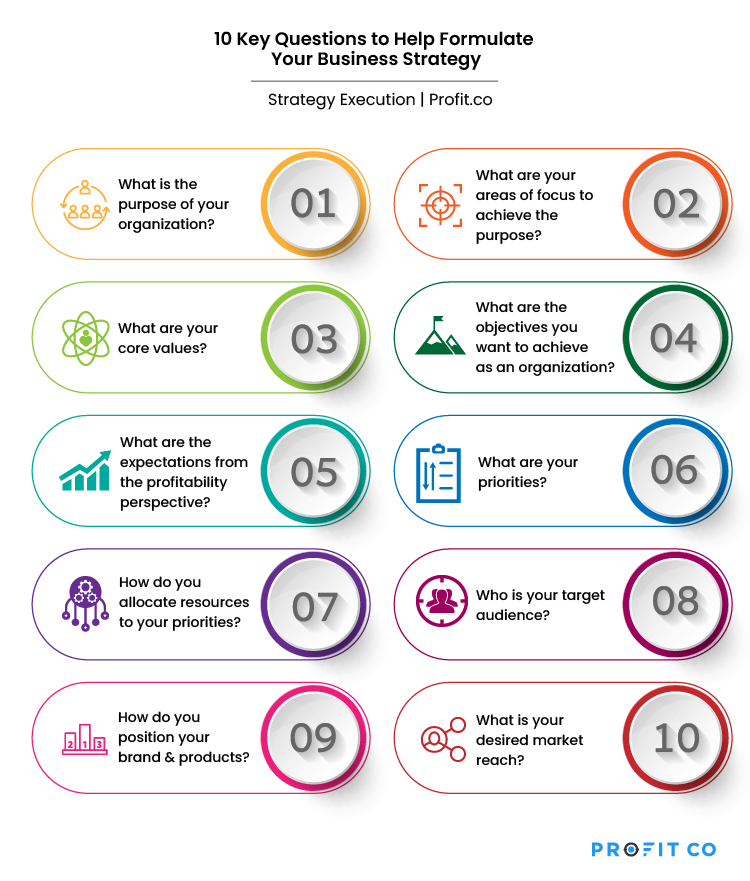The basic functioning of an organization, beneath all its complexities, involves setting targets and achieving them. If organizations are all capable of this, then every organization should theoretically have an equal chance of succeeding and being preferred by customers.
However, in practice, many organizations struggle with outlining a plan and executing it properly. Every organization envisions something and strives to create value, but successful and celebrated organizations are differentiated from others because they always stick to their vision and achieve what they promise. This sense of direction that guides the organization as a whole and its workforce is called the strategy.
The essence of strategy is choosing what not to do.
What is strategy?

Strategy is the principle and roadmap that guides the organization to envision and achieve its purpose. Strategy answers all the fundamental questions in an organization. Some of those key questions include:
- What is the purpose of your organization?
- What are your areas of focus to achieve the purpose?
- What are your core values?
- What are the objectives you want to achieve as an organization?
- What are the expectations from the profitability perspective?
- What are your priorities?
- How do you allocate resources to your priorities?
- Who is your target audience?
- How do you position your brand and products?
- What is your desired market reach?
Every initiative or product or activity in an organization must be guided by the strategy for the organization to succeed. So, implementing the strategy successfully and binding the workforce to it is extremely crucial. However, there are many challenges involved in strategy implementation.

If you’re looking for an agile, intuitive software to help manage your strategy and OKRs, look no further than Profit.co. Start your free trial today!
Why do strategy gaps occur?
Organizational strategy can be perfect on paper, but may not do well when implemented. Some strategy execution gaps may occur because of the implementation issues right from the planning phase. Let’s take a look at a few of the reasons strategy execution gaps might occur:
1. Setting the priorities wrong
Strategy gaps occur when the priorities of the organization are not set appropriately. The organization should prioritize the right things in order to achieve its objectives. When priorities are wrong, the teams will not have the clarity on the goals they need to set to achieve the organization’s objectives, and employees will not have the focus on things that will yield results.
2. Straying away from core values
Core values are the driving force of the organization, and they should be followed at every level in every activity of the organization. Strategy gaps occur when employees do not internalize core values and fail to apply them at work.
For example, let’s say that you strive to put customers first in everything you do. This is a fine value, but if your customer support systems are not easy to access, or if they are not the most customer-friendly, then it can lead to customer dissatisfaction, even if you have created a great product in line with the core values. So, strategy gaps in implementation of core values can cause major problems.
3. Lack of alignment
An organization works as a singular entity with multiple functional units that work in coordination. So, for the organization to move forward, all the units of it must move in the same direction. However, lack of goal alignment due to gaps in strategy implementation can make various teams prioritize different things, fail to achieve desired results and hold the organization back from reaching its objectives.
4. Flawed goal setting
When employees set goals that do not add up to the fulfillment of organization’s objectives, or if they do not clearly set measurable targets, they may not achieve what is expected out of them. Poor goal setting is the result of a strategy-execution gap, which can snowball into a team-level and organization-level failure.
5. Lack of coordination and communication
The organization does not achieve its objectives just because of any single individual or a team. Employees need to do work towards their respective individual targets for contributing to the success of their team, and the teams should work towards team goals for contributing to the success of the organization. Teams may need to work with each other as well when they need each other’s participation and teamwork to produce desired outcomes.
All these require strong communication and coordination amongst individuals and teams. If individuals and teams work within their own boundaries without proper coordination and communication, the outcomes they produce will not add up to the success of the organization.
6. Lack of accountability
Employees should take up ownership of the tasks as well as the objectives and core values for the strategy to be executed properly. They should have accountability for their own outcomes and the results their teams produce. If there is no clear accountability, and if there is no clear line of reporting to review the outcomes, the organization won’t be able to perform to the best of its capabilities.
How does OKR help to address these strategy gaps?
Objectives and key results (OKR) is a goal-setting framework that helps to set ambitious goals and overachieve as an organization. OKR helps to constantly monitor progress of the organization towards its objectives and identify any strategy gaps in implementation on an ongoing basis. It helps to make quick changes and achieve alignment across the organization to execute strategy flawlessly. OKR helps to address strategy gaps in the following ways:
1. OKR creates alignment
OKR helps to align the entire workforce towards organization’s objectives by means of common objectives and key results, which are broken up into team level OKRs and individual OKRs. So, there is an inherent link between OKRs at the lowest level to the organization’s objectives, creating horizontal and vertical alignment of goals and addressing any strategy gaps that occur due to lack of alignment.
2. OKR helps to prioritize and focus on the right things
When the entire organization is aligned to the objective, the workforce, starting from the company leadership all the way to teams and individuals know what needs to be done at their respective levels to achieve the objective of the organization. This drives the entire workforce to prioritize the right things when setting OKR goals at their respective levels. When there is clarity over what is important, employees focus only on the tasks that produce desired outcomes.
3. OKR brings core values into the organization culture
OKR is not limited to creating alignment and goal setting. OKR creates an organization culture where the core values of the organization are ingrained and internalized at every level of the organization through the relentless cycle of alignment, goal setting, goal achievement, review, identification of mistakes and realignment.
This makes the core values a second nature of the employees that gets reflected in everything they do. Thus OKR prevents the strategy gap that occurs due to an organization straying away from the core values.
4. OKR addresses the issues in goal setting
OKR goals are always measurable and trackable. So, it is possible to measure the impact of the goals towards the organization’s overall objectives. When achievement of short-term goals does not yield desired outcomes, periodic reviews expose the underlying issues in the goal setting process at an early stage. The concerned employees can be trained again to set OKR goals in the right way and get back to producing results. This addresses strategic gaps caused by poor goal setting.
5. OKR creates engagement, teamwork and coordination
OKR helps visualize the cross-functional nature of the work. So, it becomes evident who needs to work with whom to produce the desired outcomes. This creates synergy amongst teams to work towards common goals.
Furthermore, the OKR framework is focused on collective team outcomes rather than tasks and achievements at individual level. So, it becomes necessary for employees to interact with team members and other teams to get work done and achieve their OKR goals. The result is a harmonious and cohesive workforce that functions in tandem to produce collective outcomes, in line with the organization’s strategy, towards the organization’s objectives.
6. OKR creates ownership and accountability
OKR displays the progress made by teams and individuals for anyone in the organization to refer to at any time. It also gives individuals the freedom to choose their goals, while effectively making them responsible for the outcomes they produce. So, the employees see how others in the organization are performing. They benchmark their goals and outcomes to raise the bar higher. This creates a healthy competition and ultimately the ownership for their goals and outcomes, filling the strategy gaps caused by lack of accountability.
If you would like to learn how to manage your strategic plans and OKRs on Profit.co, schedule a free demo with the OKR experts at Profit.co!

